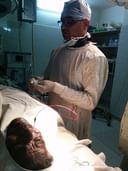Sciatica Pain - 5 Ways You Can Treat It!
Sciatica pain arises from the sciatic nerve which is the single largest nerve in our body. It consists of individual nerve roots, which branching out from the lower back of the spine to the back of each leg and combining together forms the sciatic nerve. The origination of the sciatic pain lies in the lower back of the body and radiates down the buttock to the sciatic nerve.
Causes of the sciatica pain
- Arthritis: If an individual is diagnosed with arthritis, then he or she can expect a throbbing pain or numbness down till the leg.
- Herniated disc: Another cause could be a herniated disc in the lower back of the body.
- Spondylosis: Spondylosis in the lower back would also be a reason for the development of the sciatica pain.
- PIVD/DISC bulge
Other causes are a spinal injury, diseased degenerative disc, infection on and around the lower back. The pain would worsen, if an individual is in an occupation where he or she has to stand or sit for hours at length. The lifting of heavy things would strain the sciatic nerves as well.
How to identify sciatica pain?
Sciatica pain varies from infrequent to a constant throbbing down the lower back. So initially it is difficult to detect whether it is sciatic pain or not. But when the constant pain in the lower back leads right down till the toes and foot, it is really time for an individual to get in touch with a doctor. The pain can give a burning sensation almost searing making it difficult for the person to stand up or walk properly. Along with the pain, one can feel fatigued. An involvement of the spinal cord is rare in the sciatic pain but is possible.
Treatment for sciatica pain
Sciatica can be treated in both surgical and non-surgical way. Surgical treatment is rare as sciatica tends to respond well with non-surgical treatments. If the pain continues for over a month despite treatment, surgical treatment will be considered. The non-surgical pain treatment would include physical exercises and oral medications along with natural treatment.
- Medications: Painkiller medications prescribed by the doctor can be used to reduce sciatica. Medicines like aspirin, non-steroidal or oral steroids can help reduce the pain.
- Steroid injection: Epidural steroid injection acts faster as it is injected in the affected area, thus providing relief from the pain quickly.
- Exercise: Early morning exercises can be quite helpful.
- Percutaneous Endoscopic Discectomy: The surgical treatment of Percutaneous endoscopic disc dissectomy constitutes a large part of interventional pain physicians and it has evolved considerably in terms of surgical technique and instrumentation. Percutaneous endoscopic discectomy is a relatively new technique for removing lumbar disc herniation. It involves using an endoscope to visualize the disc removal. The discectomy is performed through a posterolateral approach using specially developed instruments. The advantage of percutaneous endoscopic discectomy is that the disc is approached posterolaterally through the triangle of Kambin without the need for bone or facet resection thus preserving spinal stability. The procedure is day care and is done under local anaesthesia. If you wish to discuss about any specific problem, you can consult a pain management specialist.



+1.svg)
